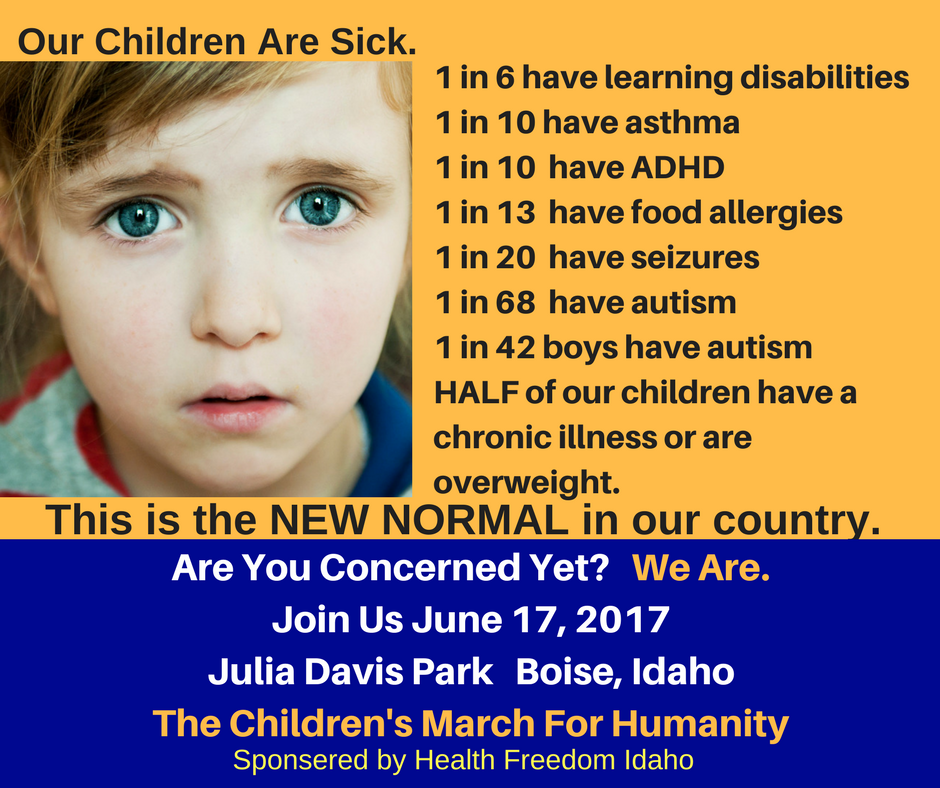Our Kids Are So Very Sick


Our Children are bombarded with toxins, overwhelmed with chronic illness and neurological disabilities. Join other families we come together as ONE VOICE on behalf of our children’s health and future.
Children’s March for Humanity will be hosted in cities nationwide. Communities coming together with the same concerns about our children’s health.
JOIN US IN BOISE At Julia Davis Park BECOME A SPONSOR of this event.
1 in 6 have learning disabilities
1 in 12 have asthma
1 in 10 have ADHD
1 in 13 have food allergies
1 in 20 have seizures
1 in 68 have autism
1 in 42 boys have autism
HALF of our children have a chronic illness or are overweight.
Learning Disabilities:
https://www.cdc.gov/ncbddd/developmentaldisabilities/about.html
Recent estimates in the United States show that about one in six, or about 15%, of children aged 3 through 17 years have a one or more developmental disabilities.1(https://www.cdc.gov/ncbddd/developmentaldisabilities/about.html#ref) Developmental disabilities are a group of conditions due to an impairment in physical, learning, language, or behavior areas. These conditions begin during the developmental period, may impact day-to-day functioning, and usually last throughout a person’s lifetime.2(https://www.cdc.gov/ncbddd/developmentaldisabilities/about.html#ref)
In 2013–14, the number of children and youth ages 3–21 receiving special education services was 6.5 million, or about 13 percent of all public school students. Among students receiving special education services, 35 percent had specific learning disabilities. –https://nces.ed.gov/fastfacts/display.asp?id=64https://nces.ed.gov/fastfacts/display.asp?id=64
Some reports estimate that as many as 15% to 20% of Americans are affected by learning disabilities and disorders. https://www.nichd.nih.gov/health/topics/learning/conditioninfo/Pages/risk.aspxhttps://www.nichd.nih.gov/health/topics/learning/conditioninfo/Pages/risk.aspx
Asthma:
The number of people with asthma continues to grow. One in 12 people (about 25 million, or 8% of the population) had asthma in 2009, compared with 1 in 14 (about 20 million, or 7%) in 2001.
Asthma is one of the most common chronic disorders affecting children.[1] It is estimated that 6.3 million children under the age of 18 have asthma in the United States.[2] Asthma is the third leading cause of hospitalization among children under age 15, and in 2008 was associated with an estimated 10.5 million missed school days.[3] The combination of illness-related absence (due to doctors’ visits as well as to illness), and potential asthma emergencies in the classroom, reduces student and teacher productivity,[4] and can negatively affect children’s academic performance.
https://www.cdc.gov/asthma/asthmadata.htm
https://www.nichd.nih.gov/health/topics/learning/conditioninfo/Pages/risk.aspx
ADHD
One in 10 children and teens has been diagnosed with attention deficit hyperactivity disorder (ADHD), according to a new government report.
http://www.webmd.com/add-adhd/childhood-adhd/news/20150514/cdc-1-in-10-children-diagnosed-with-adhd
11% of children 4-17 years of age (6.4 million) have ever been diagnosed with ADHD as of 2011
https://www.nichd.nih.gov/health/topics/learning/conditioninfo/Pages/risk.aspx
The American Psychiatric Association (APA) says that 5 percent of American children have ADHD. But the Centers for Disease Control and Prevention (CDC) puts the number at more than double the APA’s number. The CDC says that 11 percent of American children, ages 4 to 17, have the attention disorder.
Food Allergies
Researchers estimate that up to 15 million Americans have food allergies according to cdc.gov
- This potentially deadly disease affects 1 in every 13 children (under 18 years of age) in the U.S. That’s roughly two in every classroom.
- The economic cost of children’s food allergies is nearly $25 billion per year.
https://www.foodallergy.org/facts-and-stats
- Every 3 minutes, a food allergy reaction sends someone to the emergency department – that is more than 200,000 emergency department visits per year.
- A reaction to food can range from a mild response (such as an itchy mouth) to anaphylaxis, a severe and potentially deadly reaction.
- The U.S. Centers for Disease Control reported that food allergies result in more than 300,000 ambulatory-care visits a year among children under the age of 18.
- Food allergy is the leading cause of anaphylaxis outside the hospital setting.
SEIZURES
According to the latest estimates, about 1.8% of adults aged 18 years or older have had a diagnosis of epilepsy or seizure disorder.
When applied to the 2013 population, this is about 750,000 children aged 0-17 years.2When counting both children and adults, about 5.1 million people in the United States have had a diagnosis of epilepsy or a seizure disorder.1-3
Kobau R, Luo Y, PhD, Zack M, Helmers S, Thurman D. Epilepsy in adults and access to care — United States, 2012. MMWR. 2012;61(45);909-913. Accessed February 2, 2016. [PDF-863KB] .
US Census Bureau, Population Division [database online]. Annual estimates of the resident population by sex, age, race, and Hispanic origin for the United States, States, and Counties: April 1, 2010, to July 1, 2013. Release Date: June 2014. html. Accessed February 2, 2015.AUTISM
AUTISM
CDC https://www.cdc.gov/ncbddd/autism/data.html reports that 1 in 68 children has been diagnosed with autism. 1 in 6 has learning disabilities.
Researchers at the Johns Hopkins Bloomberg School of Public Health contributed to a new U.S. Centers for Disease Control and Prevention (CDC) report that finds the prevalence of autism spectrum disorder (ASD) largely unchanged from two years ago, at one in 68 children (or 1.46 percent). Boys were 4.5 times more likely to be identified with ASD than girls, an established trend. The rate is one in 42 among boys and one in 189 among girls.
ASD is a developmental disorder characterized by social and communication impairments, limited interest and repetitive behaviors. Early diagnosis and intervention are important to improving learning and skills. Rates have been rising since the 1960s, but researchers do not know how much of this rise is due to more children being diagnosed with ASD or if actual cases are increasing or a combination of both. The CDC’s first prevalance report, which was released in 2007 and was based on 2000 and 2002 data, found that one in 150 children had ASD.
For this new report, the CDC collected data at 11 regional monitoring sites that are part of the Autism and Developmental Disabilities Monitoring (ADDM) Network in the following states: Arkansas, Arizona, Colorado, Georgia, Maryland, Missouri, New Jersey, North Carolina, South Carolina, Utah, and Wisconsin. The Maryland monitoring site is based at the Johns Hopkins Bloomberg School of Public Health.





